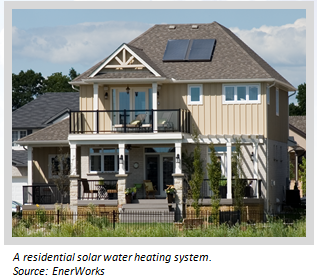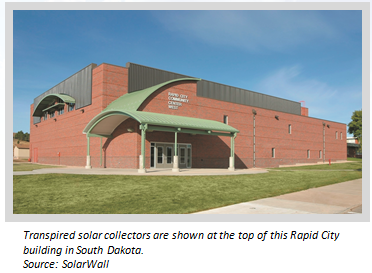Solar Heating and Cooling
Overview
Solar heating and cooling technologies collect the thermal energy from the sun and use this heat to provide hot water, space heating, cooling and pool heating for residential, commercial and industrial applications. These technologies displace the need to use electricity or natural gas.
Today, Americans across the country are at work manufacturing and installing solar heating and cooling systems that significantly reduce our dependence on imported fuels. We need smart policies to expand this fast-growing, job-producing sector.
Solar Water Heating
Solar water heating systems1 can be installed on every home in the U.S., and are composed of three main elements: the solar collector, insulated piping, and a hot water storage tank.
Electronic controls can also be included, as well as a freeze protection system for colder climates. The solar collector gathers the heat from solar radiation and transfers the heat to potable water. This heated water flows out of the collector to a hot water tank, and is used as necessary. Auxiliary heating can remain connected to the hot water tank for back-up if necessary.
In colder climates with the possibility of freezing temperatures, an indirect system is used. An antifreeze solution, such as non-toxic propylene glycol, is heated in the solar collector and circulated to the hot water storage tank via a heat exchanger. The potable water in the storage tank is warmed by the hot, antifreeze-filled heat exchanger, and the heated water can then be used as necessary, while the cooled glycol is piped back to the solar collector to be heated again.
No matter which type of solar energy system is employed, a properly designed and installed solar water heating system can be expected to provide a significant percentage (40 to 80 percent) of a building’s hot water needs.
Solar Pool Heating
Solar energy is also used to heat both commercial and residential swimming pools. The existing pool filtration system can frequently be used to transfer heat from the solar collectors to the pool water. Solar pool heating systems use different collectors, depending on the climate and on whether the pool is located outdoors or indoors.
Solar Space Heating 
Solar space heating systems are similar to solar water heating systems, but generally involve more solar collectors, larger storage units, and a more sophisticated design. These heating systems can use a non-toxic liquid, water, or air as the heat-transfer medium from the solar collector. The heated liquid or air is then circulated throughout the building or home to provide space heating.2 Another solar space heating technology uses transpired solar collectors along a building’s exterior south-facing wall. The perforations in these collectors allow air to pass through and be heated. This solar-heated air is then channeled into the building’s ventilation system.
Solar Cooling
There are two kinds of solar cooling systems: desiccant systems and absorption chiller systems. In a desiccant system, air passes over a common desiccant or “drying material” such as silica gel to draw moisture from the air and make the air more comfortable. The desiccant is regenerated by using solar heat to dry it out.
Absorption chiller systems, the most common solar cooling systems, use solar water heating collectors and a thermal-chemical sorption process to produce air-conditioning, without using electricity. The process is nearly identical to that of a refrigerator, only no compressor is used. Instead, the absorption cycle is driven by a heated fluid from the solar collector.
Solar Water Heating Collectors
Solar water heating collectors produce heat and are different from photovoltaic (PV) modules, which produce electricity.4 There are several types of collectors: flat plate, evacuated tube, Integral Collector Storage (ICS), thermosiphon, and concentrating. Flat plate collectors are the most common type of collector in the U.S.; copper pipes are affixed to an absorber plate contained in an insulated box that is covered with a tempered glass or polymer coverplate.
Evacuated tube collectors consist of rows of parallel, transparent glass tubes that have been “evacuated” of air, creating a highly efficient heat insulator for the fluid that runs inside the length of the tube.5 Evacuated tube systems are generally used when higher temperatures or higher volumes of water are needed, as well as for process heating and solar air conditioning systems.